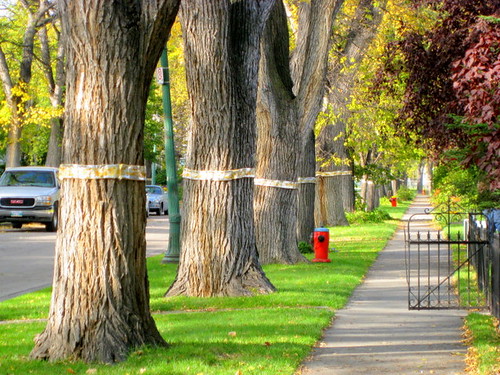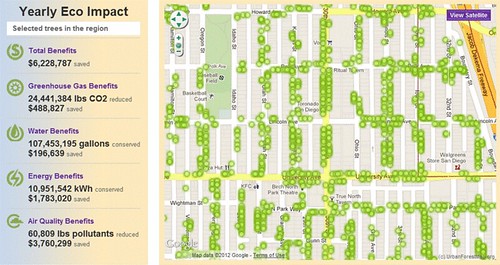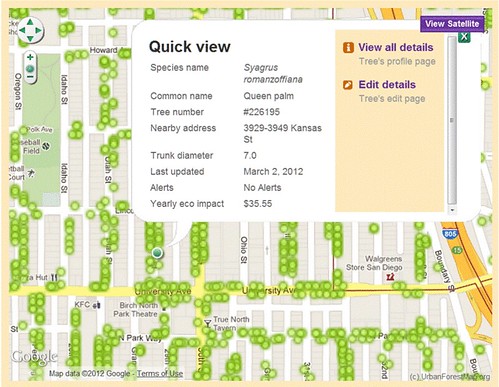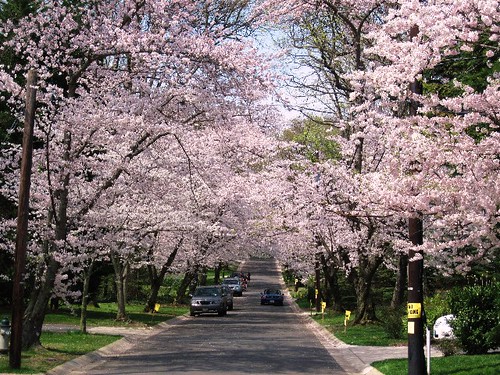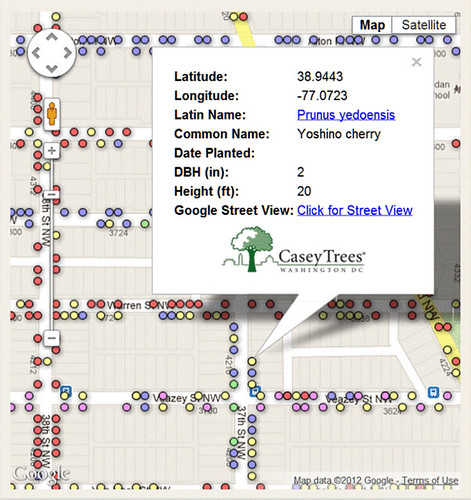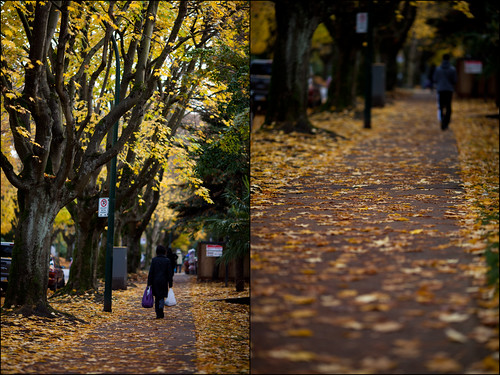What trees mean to communities: more than you may think

Posted July 31, 2012 at 1:29PM
I am lucky enough to live in a neighborhood with many large, mature trees. Our bit of urban forest is one of our community’s greatest assets, if you ask me. But, loved though they are, trees are getting to be a little controversial in and around DC, and that worries me. I’ll get to that a bit later in the post, but first I want to share some of things I have learned about city trees in the last few days.
In particular, last week I spoke at a forum hosted by the California Center for Sustainable Energy, and after the program I was approached by someone from an initiative called San Diego County Trees. The initiative is the urban forestry project of the Energy Center, and they have all sorts of information extolling the benefits of urban trees along with a crowdsourced inventory of street trees in San Diego.
I just spent time on the website, where the coolest feature is an interactive map of the whole county showing very specific tree locations and information, including quantified benefits to the region stemming (pun unintended but acknowledged) from its trees. As you can see in the image, these include carbon sequestration, water retention, energy saved, and air pollutants reduced.
You can even click on a specific tree and get detailed information on its species, size, and annual economic benefit to the community. San Diego County Trees invites its readers to add to the inventory with information on additional trees not presently counted.
If you’re interested in the subject of the community benefits of trees, you can get additional information from the websites of the National Arbor Day Foundation and the US Forest Service. Among the tidbits I learned on one or the other of those two sites are these:
- The net cooling effect of a young, healthy tree is equivalent to ten room-size air conditioners operating 20 hours a day.
- If you plant a tree today on the west side of your home, in 5 years your energy bills should be 3 percent less. In 15 years the savings will be nearly 12 percent.
- One acre of forest absorbs six tons of carbon dioxide and puts out four tons of oxygen.
- A number of studies have shown that real estate agents and home buyers assign between 10 and 23 percent of the value of a residence to the trees on the property.
- Surgery patients who could see a grove of deciduous trees recuperated faster and required less pain-killing medicine than matched patients who viewed only brick walls.
- In one study, stands of trees reduced particulates by 9 to 13 percent, and the amount of dust reaching the ground was 27 to 42 percent less under a stand of trees than in an open area.
Several years ago, walkability guru Dan Burden wrote a detailed monograph titled 22 Benefits of Urban Street Trees. Among other things, he calculated that “for a planting cost of $250-600 (includes first 3 years of maintenance) a single street tree returns over $90,000 of direct benefits (not including aesthetic, social and natural) in the lifetime of the tree.” Burden cites data finding that street trees create slower and more appropriate urban traffic speeds, increase customer traffic to businesses, and obviate increments of costly drainage infrastructure. In at least one recent study (reported after Burden’s analysis), trees were even found to be associated with reduced crime.
I think some of the most important benefits, though, are felt emotionally. Burden puts it this way:
“Urban street trees provide a canopy, root structure and setting for important insect and bacterial life below the surface; at grade for pets and romantic people to pause for what pets and romantic people pause for;
they act as essential lofty environments for song birds, seeds, nuts, squirrels and other urban life. Indeed, street trees so well establish natural and comfortable urban life it is unlikely we will ever see any advertisement for any marketed urban product, including cars, to be featured without street trees making the ultimate dominant, bold visual statement about place.”
That is extremely well said.
The DC area also has an extensive tree inventory hosted by the nonprofit Casey Trees, which has done much praiseworthy work to increase both plantings and awareness in our area. Among the several informative maps on the organization’s website is one marking trees recently planted in the city directly by the foundation. There’s also a map showing trees recently planted by the city. As with the San Diego maps, you can zoom in and click on a particular tree and bring up a popup window (see below) of tree characteristics.
Casey also publishes an annual Tree Report Card evaluating how the area is doing with respect to such performance measures as tree coverage, health, planting and protection. For 2011, for example, the organization found that tree planting has been robust and that the health of the city’s forest is strong. But the organization expressed concern about weak enforcement of the city’s tree protection law and urged both legislative and administrative changes to strengthen the city’s aggregate tree canopy, which has remained constant for several years at 35 percent coverage of the city, short of the goal of 40 percent.
Which brings me to the controversy. The Washington region, like many others in the US, has many neighborhoods (including my own) with above-ground utility lines strung overhead along our streets. We also have a lot of thunderstorms, which in some years cause significant treefall and power interruptions, most recently for the better part of a week during a severe heat wave. Utility workers strive heroically to restore service, but there are not-entirely-unfounded complaints that some of the local utilities lack sufficient preparation and have cut budgets in the wrong divisions of the company. This became a major news story, as some electricity providers performed significantly better than others in restoring electricity.
To try to shorten what could become a long story, some defensive utility executives have pointed to the trees when customers complain (“At the hearing, Pepco officials blamed trees for much of the damage to about 2,400 Pepco power lines, 200 transformers and 240 utility poles that fell during the storm”). This has been refuted by analysis, however (“By far, Pepco equipment failures, not trees, caused the most sustained power interruptions last year, records show”).
But it’s not just utilities, unfortunately. As reported by Justin Jouvenal in The Washington Post, a “massive and iconic oak that stood in the heart” of a northern Virginia suburb fell two weeks ago and crushed a car and driver underneath, killing the driver. This has prompted at least one local businessman to ask the authorities to immediately take down two nearby large, mature trees and to “deal more aggressively with aging trees” in the community. Some community members are now claiming that tree lovers “have blood on their hands,” while others believe that some of the area’s grandest trees could be casualties of an emotional rush to judgment in the wake of a tragic accident.
Personally, I am unqualified to evaluate risks and benefits in these situations. But one resident quoted in the article appears to be a voice of reason, asserting that it is important that trees be evaluated but that weight should be given to professional arborists as to their health and safety. If a tree is healthy and not posing a hazard, it should stay. I would add that, if some should indeed come down, the affected property should be replanted as soon as possible. And, as for the power lines, let’s put them underground where they belong.
Related posts:
- New evidence that city trees reduce crime (June 13, 2012)
- Nine low-tech steps for community resilience in a warming climate (March 22, 2012)
- Fixing suburbs with green streets that accommodate everyone (December 20, 2011)
- Great short video on greening smart growth with living nature (August 17, 2009)
- Biophilia: greening our cities (literally!) (July 24, 2008)
- Made in the shade - trees and walkable streets (November 29, 2007)
Move your cursor over the images for credit information.
